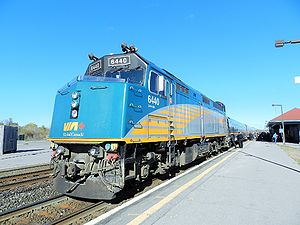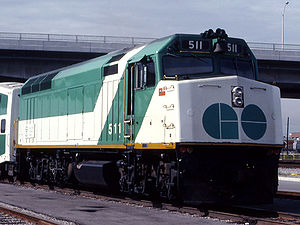General Motors Electro-Motive Division F40PH series
| GM/EMD - F40PH | |
|---|---|

| |
| General Motors Electro-Motive Division - F40PH | |
| Years of manufacture | 1975-2000 |
| Length | 56 feet, 2 inches to 69 inches |
| Width | 10 feet, 3.5 inches |
| Power/Fuel | Diesel |

| |
The General Motors Electro-Motive Division F40PH series is a 4-axle lightweight diesel-electric locomotive originally designed for service with Amtrak. Built from 1975 to the early 2000's, it was essentially a GP40-2 with a full-width body on the shorter GP35 frame, although over time the design, both in appearance and mechanically, evolved considerably. Contrary to the name, all F40's are fitted with Dash-2 equipment, although the last units built have more advanced equipment.
The F40PH was designed for corridor service, but quickly took over long-distance trains as well.
History
When Amtrak took over the passenger services of the American freight railroads in 1971, a need was immediately foreseen for a variety of different equipment to replace most of the antiquated rolling stock purchased or leased from the railroads, not the least of which was motive power. Two types of diesel locomotives were immediately identified: the first, a large high-horsepower diesel, at first equipped with steam generators but able to be equipped with Head-End Power (HEP) equipped with large fuel and water reserves and to be used on long-distance trains; the second, a smaller, lighter and faster unit equipped only with HEP (and to be used with the then-upcoming Amfleet I cars) to be used on shorter distance corridors.
Of these two types, it was felt that the first was to be the priority. EMD won the tender for what eventually became 150 units (although Amtrak did agree to purchase 25 HEP-equipped P30CH's from GE at the same time), and the SDP40F was born.
The second became the F40PH: Amtrak 200-229 were delivered in 1976, and immediately went to work on a number of short-distance corridors, including New York to Boston. They differed mechanically however, in that the HEP alternator was mechanically coupled to the main engine rather than using separate skid-mounted "gensets" as was envisioned with the SDP40F's. Because of the need to keep the frequency constant at 60 Hz, the engine must turn at a constant rate regardless of the output of the engine. As an example, the engines of VIA's own F40's normally have an output of 3000hp (~2240kW), but HEP generation diverts power from the engine and therefore only have an output of 2400hp before the HEP requirements (about 45kW per passenger coach).
Because of "parasitic" requirements of the HEP and other accessories on traction output, most F40's were actually delivered with engines that put out 3200hp, and those that weren't were often upgraded. VIA's are among the few delivered that still put out 3000hp.
Shortly after the second batch of SDP40F's entered service however, a number of troubling derailments occurred, always on shallow curves and always on the trailing unit. The lightweight hollow-bolster version of the truck they used was immediately suspected, and all trains led by SDP40F's were forced to slow down substantially for curves, throwing long-distance schedules out the window. Although the derailment issues were later traced to the above-frame water tanks as well as lightweight baggage car problems, the damage was done to the reputation of the SDP40F. For the second batch of F40PH's, 25 almost-new SDP40F's were traded in and various parts reused.
Amtrak continued to purchase more and more F40PH's (many of them reusing parts of traded-in SDP40F's) until by 1984 they had a fleet of 210 units. Many of Amtrak's units have since been replaced by the GE Genesis.
Amtrak wasn't the only one who saw the use of the type though. Many commuter agencies also saw the benefit of modernizing their fleets with F40PH's, including Metra (who ordered 115 of several types), GO Transit, MBTA and Caltrain. VIA Rail Canada purchased 2 orders of F40's in the late 1980's when they updated much of their old steam-heated equipment with HEP.
A variant of the F40PH that used a separate engine to drive the HEP generator (the F40PH-2C) was introduced in the 1980s by EMD. Morrison-Knudson, a company specializing in building 'knock-offs' and rebuilding locomotives, would continue production of this variant after the original F40PH was discontinued.
The last F40PH built by EMD, METX 214 (as an F40PHM-2), was built in 1992. Morrison-Knudsen (MK Rail) (later MotivePower Industries) built their last F40PH in the early 2000's.
Variants
- EMD F40PH
- EMD F40PHR
- EMD F40PH-2
- EMD F40PH-2C
- EMD F40PH-2D
- EMD F40PHM-2
- M-K F40PHM-2C
- M-K F40PHL-2
- MPI F40PH-2C
- MPI F40PH-3C
Specifications
Engine
- EMD 16V645E3C, 3000-3200hp, 900RPM rating
Main Generator
- GMD AR-10 Alternator
Traction Motors
- Four EMD D14 traction motors
Passenger Heat/Electric Delivery systems
- 500kW Head-End Power (HEP) system, alternator driven by main engine
- This HEP system requires the main engine to operate at a constant 900RPM to supply power, regardless of throttle setting.
- When HEP is engaged, only 2400hp is available to power the traction motors.
- 500-800kW HEP system, driven by separate engine
- This system allows the main engine to function normally, notching up and down in response to throttle changes.
- Optional: Vapor-OK Steam generator
Trucks
- 2 Blomberg 'M' four-axle trucks
Top speed 103mph (166km/h)
Fuel Capacity 1500-1800 US Gallons
Operators
Canada 
- Algoma Central Railway
- Agence métropolitaine de transport
- GO Transit
- Tshiuetin Rail Transportation
- VIA Rail Canada
United States 
- Alaska Railways
- Amtrak
- Caltrain
- COASTER
- Massachusetts Bay Transportation Authority
- Metra
- Metro-North Railroad
- Metrolink
- Music City Star
- New Jersey Transit
- Tri-Rail